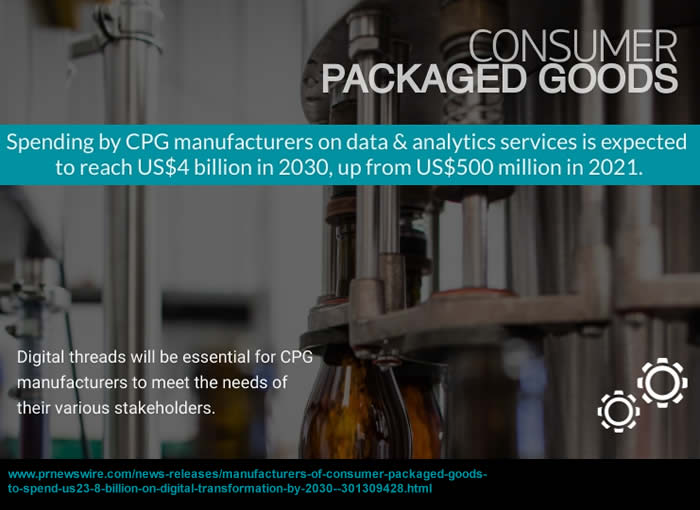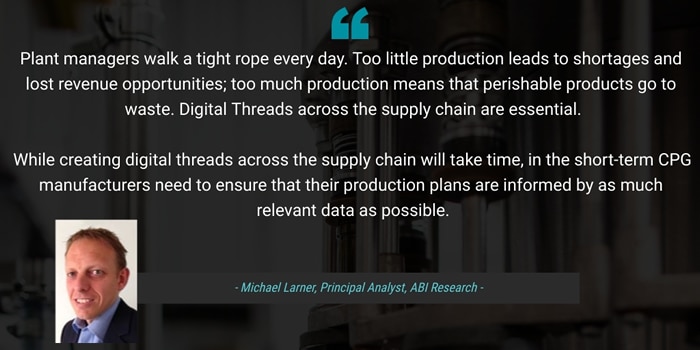Manufacturers of consumer packaged goods (CPG) leverage big data and analytics for, among others, production planning and process optimization. Digital threads become essential for CPG manufacturing companies to meet the needs of their various stakeholders and drive further investment in data and analytics services.
The consumer packaged goods industry is at the beginning of creating the data frameworks and flows (‘digital threads’) needed to meet the changing demands of stakeholders across the value chain.
In the digital transformation of CPG manufacturing companies, such so-called ‘digital threads’ are essential for the evolution towards many of the advanced benefits/capabilities sought with Industry 4.0. Yet, they are also crucial in the current CPG manufacturing environment.

For starters, they are critical on the level of the plant and the condition of ingredients and goods in the various facilities and operations as a result of evolving stakeholder demands. Gradually moving to incorporate more relevant data in connected environments is an ongoing priority as CPG manufacturers continue to transform.
By way of a reminder: de facto, a lot in Industry 4.0 is still about digitization and the basis of cyber-physical convergence (or: the first steps and conditions for relatively fast enhancements), as we recently covered.
CPG manufacturers step up data and analytics capabilities for multiple reasons
The consumer packaged goods industry and CPG manufacturing have often been used to illustrate the more advanced benefits of horizontal integration with information flows from suppliers to consumers (and back) across all intermediate levels.
These benefits are often mentioned on the level of planning (and thus efficiency, speed, costs, and waste reduction) and the dream of customized, flexible, and (semi-)autonomous mass production with an end-to-end approach.
Moreover, for some stakeholders (including consumers and regulators), it is/becomes vital to know where specific consumer packaged goods come from. Next, there’s the aspect of accountability and visibility. And the pandemic reminded us how vital flexibility and resilience are.
Until now, many CPG manufacturers, with differences in types of goods and value chain, have been relatively slow in digitally transforming and adopting technologies to go for more (advanced) capabilities. In practice, it’s the (more prominent) retail companies that often drive change. Also, on the level of data-intensive implementations, evolutions have been relatively slow.
Spending by CPG manufacturers on data and analytics services to reach US$4 billion in 2030
Yet, while the digital transformation of retail has enabled many retailers to incorporate data into their decision-making, CPG manufacturers are now starting to create digital threads that use analytics to anticipate customer demand and enhance their processes.
According to ABI Research (forecast unveiled in June 2021), CPG manufacturing companies intend to spend US$23.8 billion on digital transformation by 2030. A significant chunk of that ‘digital factory revenue’ is for spending by CPG manufacturers on data and analytics services (which, as mentioned so far, they use, for instance, to anticipate customer demand and optimize their processes), per ABI Research: US$4 billion to be precise, compared to US$500 million in 2021.

Michael Larner, Industrial and Manufacturing Principal Analyst at ABI Research, states that those digital threads across the supply chain are essential. And the reasons are simple: too little production equals shortages and lost revenue opportunities (and all the negative direct and indirect consequences such as unhappy retailers), while too much production could, for instance, mean that perishable products go to waste.
Yet, creating these digital threads takes time too. ABI Research reminds us that production planning is challenging without information from retailers’ point of sales systems. CPG manufacturers need to work with retailers, distributors, and supply chain partners to share sales information through the supply chain, from the farmer to the checkout line.
In other words: the same challenges as before. So, what to do? Making sure that as much relevant data inform production plans as possible is definitely a short-term action.
Why digital threads matter for CPG manufacturing companies in practice: examples
ABI Research gives some examples of CPG manufacturing companies that created digital threads and have set up quite intensive data programs to enhance part(s) of their operations and meet some of the demands of various stakeholders.
For the company, it’s, however, clear that (such) “digital threads will be essential for CPG manufacturers to meet the needs of their various stakeholders.”
And while everything takes time, the evolving demands of these many stakeholders, whereby one impacts the other (consumer, regulator, retailer,…), certainly won’t stop anytime soon. And, as said, it’s really on various levels of stakeholders and of ‘smart manufacturing’ goals, regardless of where CPG companies are and with their specific priorities in mind.

The few examples Larner shares are evident in this regard. CPG manufacturing companies invest in IoT and analytics to monitor conditions (temperatures, humidity levels) in their facilities and the state of ingredients and foodstuffs. This enables to enhance efficiency and minimize waste as staff is alerted if conditions change beyond acceptable parameters.
Some CPG manufacturers have more ambitious data projects. Anheuser-Busch InBev, for instance, is unifying its 27 disparate ERP systems into a single one. At the same time, Mars creates a digital thread to provide visibility from the point of origin of its raw ingredients to the point of sale.
ABI Research mentions technology companies such as AVEVA, Parsable, Seeq, and TeamViewer as well placed to support CPG manufacturers in extracting and utilizing data they generate in their facilities.
Other examples of why digital threads will be critical for CPG companies to meet stakeholder needs and necessitate CPG manufacturers to work with retailers and supply-chain operators include:
- anticipating and preparing for demand surges,
- having flexibility on production lines to accommodate trial flavors and new packaging,
- disposing of the needed documentation for regulators as evidence of how the facility handles ingredients.
These and other findings are from ABI Research’s Industry 4.0 in the Consumer-Packaged Goods Market application analysis report.

